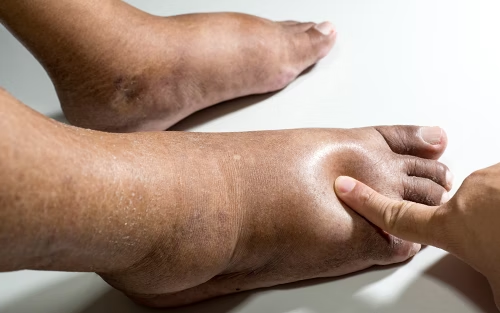What’s Causing Your Swollen Ankles, and Feet

Swollen feet, ankles, and legs are common conditions affecting many people of all ages. This condition occurs when excess fluid is trapped in the body’s tissues, causing puffiness and swelling in the affected areas.
In this article, we will discuss the causes, symptoms, diagnosis, and treatment options for swollen feet, ankles, and legs.
I. Why Are My feet swollen?
There are many potential causes of swollen feet, ankles, and legs. These causes can be divided into two categories: medical conditions and lifestyle factors.
A. Medical Conditions
- Heart Disease: Heart disease can cause the body to retain fluids, leading to swelling in the feet, ankles, and legs. Various factors, including high blood pressure, atherosclerosis, and heart failure, can cause this condition.
- Kidney Disease: Kidney disease can cause the body to retain fluids and lead to swelling in the feet, ankles, and legs. Various factors, including diabetes, high blood pressure, and infections, cause this condition.
- Liver Disease: Liver disease can cause the body to retain fluids and lead to swelling in the feet, ankles, and legs. Various factors, including alcohol abuse, hepatitis, and fatty liver disease, cause this condition.
- Blood Clots: Blood clots can cause the legs to become swollen and painful. Various factors, including immobility, surgery, and certain medical conditions, cause this.
- Lymphedema: Lymphedema is a condition that occurs when the lymphatic system is unable to drain fluid from the body properly. This condition can lead to swelling in the legs and feet.
- Arthritis: Arthritis can cause inflammation in the joints, leading to swelling in the feet, ankles, and legs.
B. Lifestyle Factors
- Standing or Sitting for Extended Periods: Standing or sitting for extended periods can cause fluid to accumulate in the legs, leading to swelling.
- Pregnancy: Pregnancy can cause the body to retain fluids, leading to swelling in the feet, ankles, and legs.
- Obesity: Obesity can put extra pressure on the legs, accumulating fluid and swelling.
- Injury: An injury to the foot or leg can cause swelling in the affected area.
II. Symptoms of Swollen Feet, Ankles, and Legs
The symptoms of swollen feet, ankles, and legs can vary depending on the underlying cause. However, some common symptoms may be present in most cases.
A. Physical Appearance
- Visible Swelling: Swelling in the feet, ankles, and legs can be visibly noticeable and may appear puffy or swollen.
- Skin Discoloration: Swelling can also cause the skin in the affected area to become discolored or reddish in appearance.
- Warmth or Redness: Swelling may be accompanied by warmth or redness in the affected area.
B. Physical Sensations
- Pain or Discomfort: Swelling can cause pain or discomfort in the affected area.
- Numbness or Tingling: Swelling can also cause numbness or tingling in the affected area.
III. Diagnosis and Treatment of Swollen Feet, Ankles, and Legs
Various factors, including fluid retention, injury, infection, and other medical conditions, can cause swollen feet, ankles, and legs.
Here is some information on diagnosis and treatment:
Symptoms of edema, which is the medical term for fluid retention, include swelling or puffiness of the tissue right under the skin, especially in legs or arms, stretched or shiny skin, skin that holds a dimple, also known as pitting, after it’s been pressed for a few seconds, increase in the size of the stomach area, and feeling of leg heaviness.
Common causes of swollen feet, ankles, and legs include prolonged standing or sitting, pregnancy, being overweight or obese, injuries, and medical conditions such as heart failure, kidney disease, and liver disease.
If you experience swelling, seeing a doctor for an accurate diagnosis is important.
Swelling can be a sign of serious medical conditions, such as heart, liver, or kidney disease. A doctor will perform a physical exam and may order diagnostic tests such as blood tests, X-rays, or ultrasounds to determine the cause of the swelling.
Treatment for swollen feet, ankles, and legs will depend on the underlying cause. In some cases, the swelling can be relieved by elevating the affected area, wearing compression stockings, and avoiding standing or sitting for prolonged periods.
Medications such as diuretics may also be prescribed to help the body eliminate excess fluid. For swelling caused by an injury or infection, treatment may include rest, ice, compression, and elevation (RICE).
Conclusion
In conclusion, swollen feet, ankles, and legs can be caused by various factors, and it’s important to see a doctor for an accurate diagnosis.
Treatment will depend on the underlying cause and may include medications, lifestyle changes, or other interventions to reduce swelling and improve overall health.